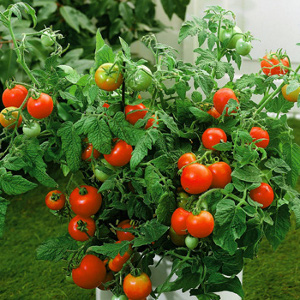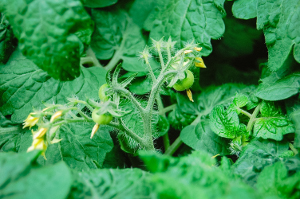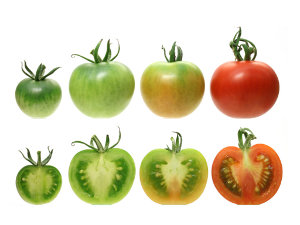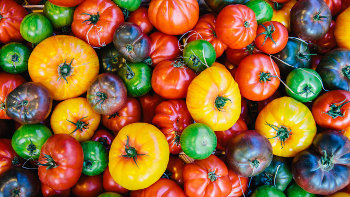Contents:
Common Names | Parts Usually Used | Plant(s) & Culture | Where Found | Medicinal Properties | Biochemical Information
Legends, Myths and Stories | Uses | Formulas or Dosages | Nutrient Content | How Sold | Warning | Resource Links
Scientific Names

- Lycopersicon esculentum
- Solanum lycopersicum
- Solanaceae family
Common Names
- Extrait de Tomate
- Love Apple
- Pomme d’Amour
- Pomme d’Or
- Raktamaci
- Tamatar
- Tomate
- Tomato Fruit
Parts Usually Used
The fruit, leaf, and vine
Back to Top
Description of Plant(s) and Culture
Tomato plants are generally much branched, spreading 60–180 cm (24–72 inches) and somewhat trailing when fruiting, but a few forms are compact and upright. Leaves are more or less hairy, strongly odorous, pinnately compound, and up to 45 cm (18 inches) long. The five-petaled flowers are yellow, 2 cm (0.8 inch) across, pendant, and clustered. Fruits are berries that vary in diameter from 1.5 to 7.5 cm (0.6 to 3 inches) or more.
Back to Top
Where Found
Tomatoes are cultivated as a vegetable worldwide.
Companion Planting is an integral part of permaculture and a holistic approach to gardening where you plant different crops in proximity for maximising the use of space, providing nutrients, shade or support, increasing crop productivity, attracting beneficial insects, pest control / repelling pests, pollination or providing a space for beneficial creatures. Tomatoes are great companion plants with: alfalfa, basil, borage, chives, coriander, dill, fennel, garlic, lavender, lemon balm, marjoram, mint, oregano, parsley, peppermint, sage, spearmint, stinging nettle, thyme and yarrow.
Back to Top
Medicinal Properties

Tomatoes have been shown to provide cancer inhibition (prostate, breast, bladder, cervix, ovaries, colorectal, gastric, endometrial, lung, oral, stomach and pancreatic); blood pressure-lowering; cholesterol-lowering; preservation of eye health and cardiovascular diseases; prevention of megaloblastic anemia in pregnant women and regulation of fetal growth.
Tomatoes offer anti-inflammatory, antibacterial, antiviral, anticarcinogenic properties.
Eating tomatoes may also help lower your risk of stroke, likely due to the lycopene they contain.
Healthy skin – the beta-carotene and lycopene found in tomatoes helps protect the skin against damage and makes skin less sensitive to UV damage.
Strong bones – the vitamin K, calcium and lycopene in tomatoes is good for strengthening and repairing bones as well as improving bone mass.
Regulates blood sugar – tomatoes contain chromium which helps your blood sugar stay in balance and helps reduce the risk of diabetes.
Improves vision – vitamin A found in tomatoes can improve vision, help prevent night blindness and may help reduce the risk of macular degeneration.
Prevents kidney stones and gallstones – studies have shown that eating tomatoes may lessen the risk of developing kidney stones and gallstones.
Prevents heart disease – the potassium and vitamin B in tomatoes helps lower blood pressure and cholesterol levels which in turn can assist in the prevention of strokes, heart attacks and other heart related problems.
Researchers concluded that, “this study demonstrated that a tomato-rich diet is independently related to lower prevalence of depressive symptoms. These results suggest that a tomato-rich diet may have a beneficial effect on the prevention of depressive symptoms.
Biochemical Information
Tomatoes contain carotenoids such as lycopene, β-Carotene, lutein as well as phenolic compounds such as flavonoids, phenolic acids and tannins.
Back to Top
Legends, Myths and Stories

The idea that tomato leaves are poisonous because the plant belongs to the nightshade family is mostly a myth. In order for a person to be harmed by eating tomato leaves would actually required them to eat at least a pound and a half of them.
As recently as 200 years ago, tomatoes were considered to be poisonous in the U.S. because of their membership in the nightsade family. Tomatoes are now the fourth most popular fresh-market vegetable behind potatoes, lettuce, and onions. In fact, annually, the average American consumes 17.9 pounds of fresh tomatoes (Lycopersicon esculentum) and 68.7 pounds of processed tomato products.
Is a tomato considered a vegetable or a fruit? Scientifically speaking, it’s considered a fruit because the body of the tomato contains seeds. However, if you’re a history buff, you’ll find information that shows the U.S. Supreme Court declared the tomato a vegetable in 1893.
A genetically modified tomato, or transgenic tomato, is a tomato that has had its genes modified, using genetic engineering. The first trial genetically modified food was a tomato engineered to have a longer shelf life (the Flavr Savr), but never made it to market. Currently there are no genetically modified tomatoes available commercially, but scientists are developing tomatoes with new traits like increased resistance to pests or environmental stresses.
A wild tomato species originated in the Andes Mountains of South America, probably mainly in Peru and Ecuador, and is thought to have been domesticated in pre-Columbian Mexico; its name is derived from the Náhuatl (Aztec) word tomatl. The tomato was introduced to Europe by the Spanish in the early 16th century, and the Spanish and Italians seem to have been the first Europeans to adopt it as a food.
Tomatoes were introduced to North America from Europe. Thomas Jefferson is known to have raised them at Monticello in 1781. The tomato was used for food in Louisiana as early as 1812, but not in the northeastern states until about 1835. It did not attain widespread popularity in the United States until the early 20th century. The plant is now grown commercially throughout the world.
Back to Top
Uses
Tomatoes are used in many global cuisines and add an umami flavor to foods.
Tomatoes are used for preventing cancer of the breast, bladder, cervix, colon and rectum, stomach, lung, ovaries, pancreas, and prostate. It is also used to prevent diabetes, diseases of the heart and blood vessels (cardiovascular disease), cataracts, and asthma.
Back to Top
Formulas or Dosages
Men who eat over 10 portions a week of tomatoes have an 18 per cent lower risk of developing prostate cancer, new research suggests.
Doctors recommend eating at least 10,000 micrograms of lycopene per day. Keep in mind that lycopene is better absorbed in the body when it’s combined with some fat.
Tomato lycopene-containing foods:
| Food | Micrograms of lycopene |
| 1/2 cup canned tomato puree | 27,192 |
| 1 cup canned tomato juice | 21,960 |
| 1/2 cup ready-to-serve marinara sauce | 6,686 |
| 1 tablespoon canned tomato paste | 3,140 |
| 1 tablespoon catsup | 2,506 |
| 1 tablespoon salsa | 1,682 |
| One sun-dried tomato | 918 |
| One slice of raw tomato | 515 |
| One cherry tomato | 437 |
Source: USDA National Nutrient Database
Back to Top
Nutrient Content

One cup of chopped or sliced raw tomatoes contains:
- 32 calories (kcal)
- 170.14 g of water
- 1.58 g of protein
- 2.2 g of fiber
- 5.8 g of carbohydrate
- 0 g cholesterol
- 18 mg of calcium
- 427 mg of potassium
- 43 mg of phosphorus
- 24.7 mg of vitamin C
- 1499 international units (IU) of vitamin A
- alpha-lipoic acid
- lycopene
- choline
- folic acid
- beta-carotene
- lutein
Cooking tomatoes seems to increase the availability of key nutrients, such as the carotenoids lycopene, lutein, and zeaxanthin. Stewed tomatoes provide more lutein and zeaxanthin than sun-dried tomatoes and raw cherry tomatoes.
Back to Top
How Sold
Tomatoes are sold fresh and in a myriad of other forms at the grocery.
Back to Top
Warning
Every year, the Environmental Working Group (EWG) compiles a list of fruits and vegetables with the highest levels of pesticide residue. These foods are known as the Dirty Dozen. For 2017, tomatoes are number 10 and cherry tomatoes number 14 on the list. Though it has not been proven that eating organic foods has overall health benefits, the EWG suggests that people should buy organic tomatoes where possible. Buying organic minimizes pesticide exposure, though this has not been definitively proven to prevent disease. Remember to wash tomatoes before eating.
Beta-blockers, a type of medication most commonly prescribed for heart disease, can cause potassium levels to increase in the blood. High potassium foods such as tomatoes should be consumed in moderation when taking beta-blockers.
Those with gastroesophageal reflux disease (GERD) may experience an increase in symptoms such as heartburn and vomiting when consuming highly acidic foods such as tomatoes. Individual reactions vary.
Although tomato allergy is rare, individuals allergic to grass pollen are more likely to be allergic to tomatoes.
Back to Top
Resource Links
Tomatoes Lower Risk of Breast Cancer
Michigan State University: Tomatoes provide many health benefits
An Update on the Health Effects of Tomato Lycopene
Lycopersicon esculentum (Tomato) Prevents Adverse Effects of Lead on Blood Constituents
Tomato (Lycopersicon esculentum) prevents lead-induced testicular toxicity
α-tomatine inhibits growth and induces apoptosis in HL-60 human myeloid leukemia cells
The Journal of Nutrition: The Tomato As a Functional Food
Penn State Extension: Health Benefits of Tomatoes
Harvard Helth Publishing: Lycopene-rich tomatoes linked to lower stroke risk
Why Is This Wild, Pea-Sized Tomato So Important?
Are Tomato Leaves Actually Poisonous?
Polyphenol Consumption and Blood Pressure
MedicalNewsToday: Everything you need to know about tomatoes
Enhancing the Health-Promoting Effects of Tomato Fruit for Biofortified Food
Effects of bioactive compounds occurring in tomato.
Main anti-inflammatory and antioxidant effects of bioactive tomato compounds.
An Update on the Health Effects of Tomato Lycopene
Tomato Consumption and Health: Emerging Benefits
Diet Rich in Apples and Tomatoes May Help Repair Lungs of Ex-Smokers, Study Suggests
Diet rich in tomatoes cuts skin cancer in half in mice
Does a tomato a day keep depression away?
Muse for cancer-fighting tomatoes study? Italian food
Wikipedia: Genetically modified tomato
Tomatoes, Tomato-Based Products, Lycopene, and Cancer: Review of the Epidemiologic Literature
Latest research on tomatoes, lycopene & prostate cancer
University of Cambridge: Fighting prostate cancer with a tomato-rich diet
